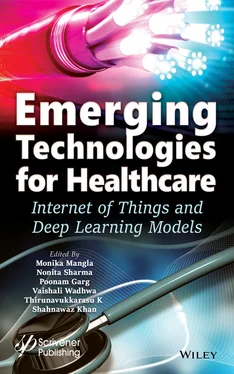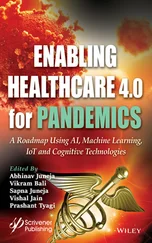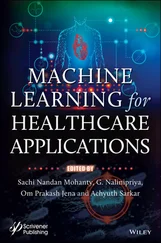The data generated through IoT devices are prone to security threats. Maintaining the privacy of the patient data is of utmost importance. Traditional encryption schemes cannot be applied on healthcare data due to the limitations in the properties of digital data. A chaos-based encryption cryptosystem to preserve the privacy of patients is proposed in [15]. Random images are generated by the cryptosystem which ensures highest security level for the patient data. The performance of this model was found to be better than other encryption schemes.
The trends of IoT in healthcare sectors and the future scope for research is discussed in [16]. A sensor-based communication architecture and authentication scheme for IoT-based healthcare systems is addressed in [17]. Various research articles on big data analytics, and IoT in healthcare is addressed in [18].
With the enormous research happening in the field of IoT applications in healthcare sectors, new dimensions to the healthcare treatments and hospital services can be expected in the coming years.
1.2 Influence of IoT in Healthcare Systems
Due to the awareness about the importance of healthy life, people have become more health conscious nowadays. Humans are finding new ways to improve and track their health. Due to the implementation of emerging technologies like IoTs and Artificial Intelligence (AI), the healthcare systems have evolved as an entirely new system replacing the old system. Various stages of IoT system is shown in Figure 1.1.
Various developments have occurred in the healthcare systems in the recent past. Some of the advancements are discussed in this section.
Health monitoring on real-time basis became possible due to the invention of wearable smart gadgets. These devices continuously monitor various parameters like blood pressure, heart rate, oxygen level, and calories burnt. Fitness bands helps individuals to maintain their body healthy and fit by regularly alerting them about the steps taken per day and how much calories needs to be burnt to stay healthy.

Figure 1.1 Stages of IoT.
These devices can be interconnected by IoT devices so that the healthcare workers and immediate family members can monitor the parameters and they will be alerted for any emergency situation. Such devices are very helpful for elderly persons who are living alone as they get immediate medical attention if there are variations in their body parameters.
Smart hospitals mean all the equipment in the hospitals are connected through IoTs in addition to real-time monitoring system for the patients. Managing the assets in the hospitals can be made in a smarter way by means of IoTs. The equipment like oxygen cylinders, wheelchairs, and nebulizers can be tracked on real-time basis and made available when in need.
Now, in the current Covid-19 scenario, we have observed how the hospitals were managing the resources in a smarter way. The number of occupied beds and available bed status is updated on real-time basis, and the data is made available in various digital platforms.
Cleanliness and hygiene also can be maintained in an efficient manner. Environmental conditions like humidity and temperature can be monitored continuously and the spread of diseases can be prevented efficiently.
Due to the advancement of technology, hospitals have become more patient friendly. The duration of hospital stay can be reduced due to the online real-time monitoring of the patient data through IoT devices. It is easier for doctors to track the patient data at the comfort of sitting at a remote location. As the IoT devices are attached to the patients, continuous monitoring of the vital parameters is possible, and the doctors will be alerted for any variations in the parameters.
These smart devices not only track the patient’s health parameters but also alert the patients for their consultation schedules. It also keeps the records of previous medications or medical history which aids the doctors in right diagnosis and treatments.
The availability of patient’s data on IoT devices helps the hospitals to track the patients and provide quick medical attention in an efficient manner.
1.2.4 Transparent Insurance Claims
Healthcare insurance policy holders are increasing on a yearly basis. Due to the large number of policy holders who aims to get maximum profits by claiming the insurance, false claims are also increasing. Due to the presence of IoT devices which tracks the patient data, insurance companies can easily detect any fraud in the claims.
These devices not only help the patients to manage their insurance policies but also help the insurance companies to track the health of patients, underwriting, risk assessments, etc. Due to the IoT-enabled devices, the insurance claims became transparent and benefitting the genuine policy claims.
Population in cities are more compared to the rural areas as people prefer to have better quality and standards of living in cities with better facilities and infrastructures. Most of the cities are crowded and majority of the population use public and private transport for commuting. Vehicle densities in cities are more compared to villages which lead to more air pollution which, in turn, affect the health of the individuals and the environment.
Due to the advancement in technology in terms of usage of IoT devices, continuous real-time monitoring of the air quality is possible. The tracking of the air quality patterns helps the authorities to take appropriate actions to improve the air quality which, in turn, help to maintain a healthier city.
1.2.6 Research in Health Sector
Research in medical field is a continuous process which requires lot of time in gathering the patient data and analyzing it. Connected devices through IoTs generate large amount of real-time data which can be used for research purposes in an efficient manner as data collection becomes much easier with less amount of time and money. Statistical and comparative study analysis is possible as these devices can be connected anywhere in the world and data can be generated which will aid in medical research.
Innovative methods of treatments can be introduced by doing proper research in an efficient and quick manner due to the presence of IoT devices. This also helps to improve the healthcare services.
Smart monitoring devices will monitor all the parameters inside a medical laboratory and alerts if there is an abnormality so that immediate action can be taken. Based on the data available, various research studies can be done with much ease.
1.3 Popular IoT Healthcare Devices
New devices are invented to match with the technological advancements. These new devices aim to make the life easier for humans. Some of the popular IoT devices for healthcare are as follows:
Hearables are one of the popular IoT devices which are used by the people for hearing aid. With these devices, people who have difficulty in hearing or those who are hearing impaired can interact with the outside world. This device can be connected with other smart devices like mobile phones and data can be synchronized. Various types of filters and equalizers are used for better user experience to match with the real sounds.
Читать дальше













